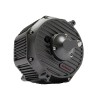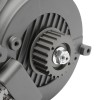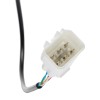Description
Seeking more power, increased torque, extended top-end, and freedom from overheating? Sounds impossible and yet you’re at the right place. Whether you’re conquering mountain peaks or cruising on the asphalt, this engine provides an extra surge of power, leaving mountain goats and petrol bikes in the dust.
Behold, the Sotion Motor MTO Racing Edition, meticulously crafted from the ground up for the Sur Ron Light Bee. With a bigger rotor, an enlarged stator, and the ground breaking IPM technology, it’s not just about gaining power; it’s a radical efficiency overhaul.
MTO Racing Edition
The MTO Racing Edition focuses on enduro riding. Unlike pure MX riding, enduro needs performance in extremely various situations: from crazy torque-demanding uphills to wide open at more than 100km/h to trial zones asking for instant torque burst.
After extensive riding with various controllers, Quentin required some winding tuning for a better performance distribution. In a word, it heats up less at low speed, is more linear in the torque distribution and will still tear off your arms if you pin the throttle.
Picture this: Quentin wrestled with thermal management issues, the stock motor pushing temperatures well beyond 200°C at 18kW. Enter the Sotion, and suddenly, that’s distant memory. Quentin effortlessly cruises at 25kW, and the motor barely breaks a sweat at 60°C.
Now, let’s talk power, and we’re not messing around here:
- A jaw-dropping 13kW continuous power and a mind-boggling 26kW peak power.
- A torque of 22Nm at the shaft (peaking at 65Nm) that’ll give you goosebumps.
- Revving up to 5200rpm at nominal voltage, with an insane 10 000rpm at peak speed.
Numbers might sound mundane, so here’s a story for you: Quentin shared the road with the Stark Varg and with the Sotion motor at play, the Stark simply couldn’t escape.
Now buckle up, because when you hit the throttle, it’s not just going to pull; it’s going to pull hard, really hard! Get ready to be swept away in a symphony of raw energy that transcends the ordinary and propels you into the extraordinary.
Hall sensor vs. Encoder
When it comes to choosing between the Hall sensor and the Encoder, we’ll skip the overly technical stuff to keep things clear.
Simply put, the Hall sensor has the advantage of being supported by all controllers and being more reliable thanks to a simpler design.
On the paper it’s slightly less precise than an encoder, but let’s be realistic: encoders are often used in precision CNC machines, we don’t need nanometer precision here. All the more that most controllers switch to sensorless beyound 5-10km/h.
This is the very reason we chose Hall Sensor as a default. Now if Encoder is your cup of tea, we keep them readily available and switching is litteraly a 30sec task that could be done by a 6 year old.
Compatible controllers include: the Nucular, the Torp TC500 (from 2023), the TC 1000, the EBMX X9000 and the Far Driver.
Technical details
| Motor Type |
Brushless IPM motor |
| Power |
13kW nominal and 26kW peak |
| Torque |
22Nm nominal and 65Nm peak |
| Max phase |
800A phase current |
| RPM |
5200RPM at nominal voltage with a maximum of 10 000RPM |
| Position sensor |
Hall sensor |
| Temperature sensor |
NTC KTY83 |
| Motor poles |
10 poles making it a 5 pole pairs |
| Assembly |
Full aluminium body, aluminium rotor, neodimium magnets |
| Efficiency |
93% |
| Weight |
11kg |




